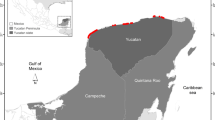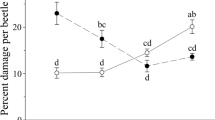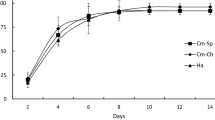Abstract
The presence of alien invasive species has serious negative impact on endemic biodiversity, especially on native species that occupy the same niche in the ecosystem. To study the influence of the alien invasive species Bursaphelenchus xylophilus on its native sister species B. mucronatus, the two nematode species were mix-cultured in a fungal mat and mix-inoculated into a susceptible host. By comparing the propagation parameters of both species under competitive and noncompetitive conditions it was shown that the propagation level of B. xylophilus was clearly higher than that of B. mucronatus under laboratory culture. Furthermore, the propagation capacity of B. xylophilus under competitive conditions was much higher than that under noncompetitive conditions, both in laboratory culture and with host inoculation. Bursaphelenchus xylophilus also excluded B. mucronatus when the two species were cultured as a mixture for a longer time. The relative abundance ratios of the two species in natural pinewoods were also determined by random sampling of dying pine trees from regions with different invasion histories. It was noted that with an increase in invasion years the distribution frequency of B. xylophilus increased while that of B. mucronatus decreased. Experimental tests verified our hypothesis that because of its high fecundity and strong competitive ability, the invasive species B. xylophilus out-competed the native species B. mucronatus and displaced it in natural ecosystems. The successful invasion of B. xylophilus is attributed to competitive displacement, which may be one of the ecological invasive mechanisms.






Similar content being viewed by others
References
Abad P, Tares S, Brugier N, de Guiran G (1991) Characterisation of the relationships in the pinewood nematode species complex (PWNSC) (Bursaphelenchus spp.) using a heterologous unc-22 DNA probe from Caenorhabditis elegans. Parasitology 102:303–308
Blackmore MS, Charnov EL (1989) Adaptive variation in environmental sex determination in a nematode. Am Nat 134:817–823
Bohn T, Amundsen PA, Sparrow A (2007) Competitive exclusion after invasion? Biol Invasions. doi: 10.1007/s10530-007-9135-8
Braks MAH, Honório NA, Lounibos LP et al (2004) Interspecific competition between two invasive species of container mosquitoes, Aedes aegypti and Aedes albopictus (Diptera: Culicidae), in Brazil. Ann Entomol Soc Am 97:130–139
Brown BJ, Mitchell RJ, Graham SA (2002) Competition for pollination between an invasive species (Purple loosestrife) and a native congener. Ecology 83:2328–2336
Byers JE (2000) Competition between two estuarine snails: implications for invasions of exotic species. Ecology 8:1225–1239
Callaway RM, Aschehoug ET (2000) Invasive plants versus their new and old neighbors: a mechanism for exotic invasion. Science 290: 521–523
De Guiran G, Bruguier N (1989) Hybridisation and phylogeny of the pinewood nematode (Bursaphelenchus spp.). Nematologica 35:321–330
Edgerly JS, Willey MS, Livdahl TP (1993) The community ecology of Aedes egg hatching: implications for a mosquito invasion. Ecol Entomol 18:123–128
Futai K (1980) Developmental rate and population growth of Bursaphelenchus lignicolus (Nematoda: Aphelenchiodidae) and B. mucronatus. Appl Entomol Zool 15:115–122
García-Serrano H, Sans FX, Escarre J (2007) Interspecific competition between alien and native congeneric species. Acta Oecol 31:69–78
Gurevitch J, Padilla DK (2004) Are invasive species a major cause of extinctions? Trends Ecol Evol 19:470–474
Holway DA (1999) Competitive mechanisms underlying the displacement of native ants by the invasive Argentine ant. Ecology 80:238–251
Holway DA, Suarez AV (1999) Animal behavior: an essential component of invasion biology. Trends Ecol Evol 14:328–330
Hulin V, Guillon JM (2007) Female philopatry in a heterogeneous environment: ordinary conditions leading to extraordinary ESS sex ratios. BMC Evol Biol 7:13. doi: 10.1186/1471-2148-7-13
Iwahori H, Tsuda K, Kanzaki N et al (1998) PCR-RFLP and sequencing analysis of ribosomal DNA of Bursaphelenchus nematodes related to pine wilt disease. Fundam Appl Nematol 21:655–666
Iwahori H, Kanzaki N, Futai K (2002) Bursaphelenchus xylophilus and B. mucronatus in Japan: where are they from? Paper presented at the Fourth International Congress of Nematology, Spain
Jikumaru S, Togashi K (2003) Boarding abilities of Bursaphelenchus mucromus and B. xylophilus (Nematoda: Aphelenchoididae) on Monochamus alternatus (Coleoptera: Cerambicidae). Nematology 5:843–849
Juliano SA (1998) Species introduction and replacement among mosquitoes: interspecific resource competition or apparent competition. Ecology 79:255–268
Kneitel JM, Chase JM (2004) Trade-offs in community ecology: linking spatial scales and species coexistence. Ecol Lett 7:69–80
Lin W, Zhou G, Cheng X, Xu R (2007) Fast economic development accelerates biological invasions in China. PLoS ONE 2(11):e1208. doi:10.1371/journal.pone.0001208
Mamiya Y, Enda N (1979) Bursaphelenchus mucromus n. sp. (Nematoda: Aphelenchoididae) from pine wood and its biology and pathogenicity to pine trees. Nematologica 25:353–361
Mooney HA, Cleland EE (2001) The evolutionary impact of invasive species. PNAS 98:5446–5451
Nickel WR, Golden AM, Mamiya Y et al 1981. On the taxonomy and morphology of the pinewood nematode, Bursaphelenchus xylophilus (Steiner & Buhrer, 1934) Nickle, 1970. J Nematol 13: 385–392
Petren K, Case TJ (1996) An experimental demonstration of exploitation competition in an ongoing invasion. Ecology 77:118–132
Petren K, Bolger DT, Case TJ (1993) Mechanisms in the competitive success of an invading sexual gecko over an asexual native. Science 259:354–358
Reitz SR, Trumble JT (2002) Competitive displacement among insects and arachnids. Annu Rev Entomol 47:435–465
Rutherford TA, Riga E, Webster JM (1992) Temperature-mediated behavioural relationships in Bursaphelenchus xylophilus, B. mucronatus and their hybrids. J Nematol 24:40–44
SPSS Inc (1999) SPSS for Windows. Version 10.0
Thorne G (1961) Principles of nematology. McGraw-Hill, New York
Vila M, Weiner J (2004) Are invasive plant species better competitors than native plant species?—evidence from pair-wise experiments. Oikos 105:229–238
Vrain TC, Wakarchuk DA, Levesque AC et al (1992) Intraspecific rDNA restriction fragment length polymorphism in the Xiphinema americanum group. Fundam Appl Nematol 15:563–573
Webster JM, Anderson RV, Baillie DL et al (1990) DNA probes for differentiating isolates of the pinewood nematode species complex. Rev Nematol 13:255–263
Wauters LA, Tosi G, Gurnell J (2002) Interspecific competition in tree squirrels: do introduced grey squirrels (Sciurus carolinensis) deplete tree seeds hoarded by red squirrels (S. vulgaris)? Behav Ecol Sociobiol 51:360–367
Wilson KA, Magnuson JJ, Lodge DM et al (2004) A long-term rusty crayfish (Orconectes rusticus) invasion: dispersal patterns and community change in a north temperate lake. Can J Fish Aquat Sci 61:2255–2266
Yang BJ, Tang J, Wang YY, Pang HY, Wang LF (2003) Pine wilt disease. Chinese Forest Publishing House, Beijing
Zang L, Liu S, Liu Y et al (2005) Competition between the B biotype and a non-B biotype of the whitefly, Bemisia tabaci (Homoptera: Aleyrodidae) in Zhejiang, China. Biodivers Sci 13:181–187
Acknowledgements
This work was supported by the State Key Basic Research and Development Plan (2002CB111400), the National Nature Science Foundation of China (30570288) and the National Scientific and Technical Supporting Programs (2006BAD08A19116).
Author information
Authors and Affiliations
Corresponding author
Rights and permissions
About this article
Cite this article
Cheng, XY., Xie, PZ., Cheng, FX. et al. Competitive displacement of the native species Bursaphelenchus mucronatus by an alien species Bursaphelenchus xylophilus (Nematoda: Aphelenchida: Aphelenchoididae): a case of successful invasion. Biol Invasions 11, 205–213 (2009). https://doi.org/10.1007/s10530-008-9225-2
Received:
Accepted:
Published:
Issue Date:
DOI: https://doi.org/10.1007/s10530-008-9225-2




